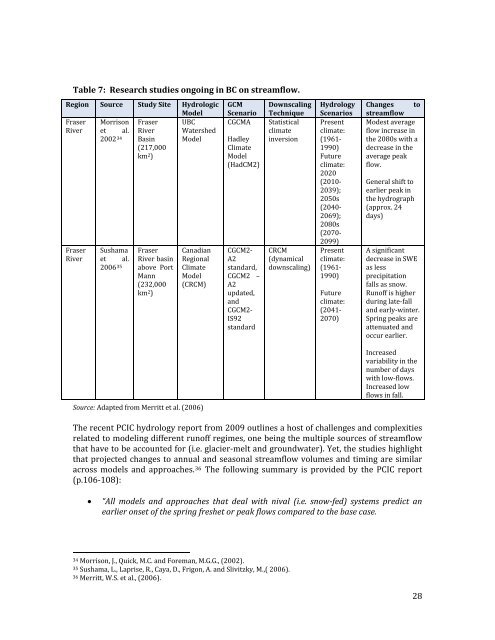From: on behalf of Panel Registry Subject: FW: TNG registration of ...
From: on behalf of Panel Registry Subject: FW: TNG registration of ...
From: on behalf of Panel Registry Subject: FW: TNG registration of ...
Create successful ePaper yourself
Turn your PDF publications into a flip-book with our unique Google optimized e-Paper software.
Table 7: Research studies <strong>on</strong>going in BC <strong>on</strong> streamflow.<br />
Regi<strong>on</strong> Source Study Site Hydrologic<br />
Model<br />
Fraser Morris<strong>on</strong><br />
River et al.<br />
200234 Fraser<br />
River<br />
Basin<br />
(217,000<br />
km2) UBC<br />
Watershed<br />
Model<br />
Fraser<br />
River<br />
Sushama<br />
et al.<br />
2006 35<br />
Fraser<br />
River basin<br />
above Port<br />
Mann<br />
(232,000<br />
km 2)<br />
Canadian<br />
Regi<strong>on</strong>al<br />
Climate<br />
Model<br />
(CRCM)<br />
Source: Adapted from Merritt et al. (2006)<br />
GCM<br />
Scenario<br />
CGCMA<br />
Hadley<br />
Climate<br />
Model<br />
(HadCM2)<br />
CGCM2‐<br />
A2<br />
standard,<br />
CGCM2 –<br />
A2<br />
updated,<br />
and<br />
CGCM2‐<br />
IS92<br />
standard<br />
Downscaling<br />
Technique<br />
Statistical<br />
climate<br />
inversi<strong>on</strong><br />
CRCM<br />
(dynamical<br />
downscaling)<br />
Hydrology<br />
Scenarios<br />
Present<br />
climate:<br />
(1961‐<br />
1990)<br />
Future<br />
climate:<br />
2020<br />
(2010‐<br />
2039);<br />
2050s<br />
(2040‐<br />
2069);<br />
2080s<br />
(2070‐<br />
2099)<br />
Present<br />
climate:<br />
( 1961‐<br />
1990)<br />
Future<br />
climate:<br />
(2041‐<br />
2070)<br />
Changes to<br />
streamflow<br />
Modest average<br />
flow increase in<br />
the 2080s with a<br />
decrease in the<br />
average<br />
peak<br />
flow.<br />
General shift to<br />
earlier peak in<br />
the hydrograph<br />
(approx. 24<br />
days)<br />
A significant<br />
decrease in SWE<br />
as less<br />
precipitati<strong>on</strong><br />
falls as snow.<br />
Run<strong>of</strong>f is higher<br />
during late‐fall<br />
and early‐winter.<br />
Spring peaks are<br />
attenuated<br />
and<br />
occur earlier.<br />
Increased<br />
variability in the<br />
number <strong>of</strong> days<br />
with low‐flows.<br />
Increased low<br />
flows in fall.<br />
The recent PCIC hydrology report from 2009 outlines a host <strong>of</strong> challenges and complexities<br />
related to modeling different run<strong>of</strong>f regimes, <strong>on</strong>e being the multiple sources <strong>of</strong> streamflow<br />
that have to be accounted for (i.e. glacier‐melt and groundwater). Yet, the studies highlight<br />
that projected changes to annual and seas<strong>on</strong>al streamflow volumes and timing are similar<br />
across<br />
models and approaches. 36 The following summary is provided by the PCIC report<br />
( p.106‐108):<br />
• “All models and approaches that deal with nival (i.e. snowfed) systems predict an<br />
earlier <strong>on</strong>set <strong>of</strong> the spring freshet or peak flows compared to the base case.<br />
34 Morris<strong>on</strong>, J., Quick, M.C. and Foreman, M.G.G., (2002).<br />
35 Sushama, L., Laprise, R., Caya,<br />
D., Frig<strong>on</strong>, A. and Slivitzky, M.,( 2006).<br />
36 Merritt, W.S. et al., (2006).<br />
28
















